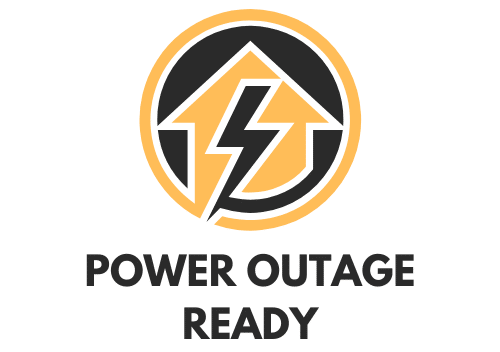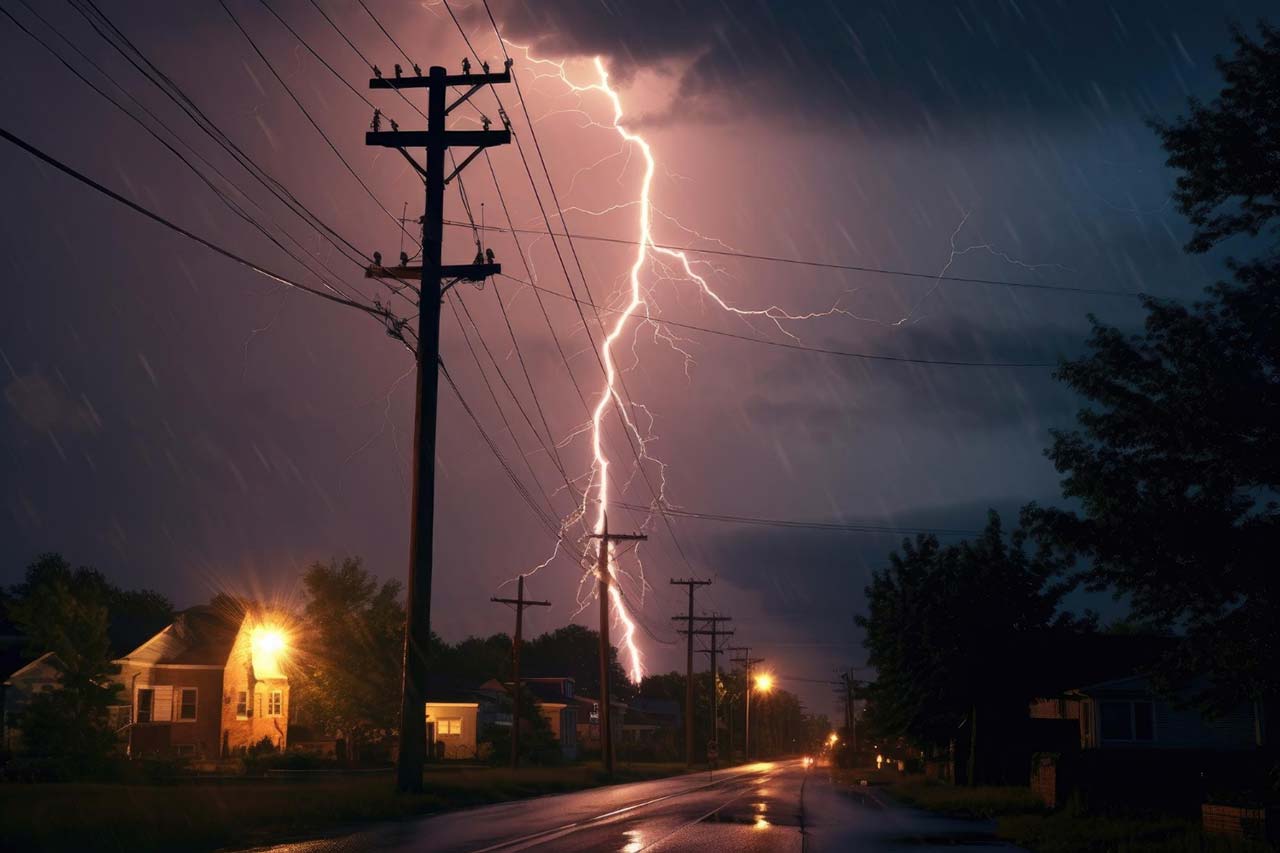What Causes Power Outages? (Common Triggers)
Power outages can strike at any time, leaving you in the dark and scrambling for a backup plan. When it comes to fully preparing for these frustrating events, it’s essential to understand why they happen, so you can take the proper steps to minimize the impact on your daily life. Ready to dive into some of the common causes of power outages? Let’s do it.
Natural Causes of Power Outages
Weather is one of the leading culprits behind power outages, and Mother Nature has quite a few tricks up her sleeve. Strong winds from storms, hurricanes, and heavy snowfall often wreak havoc on electrical systems, knocking down power lines and tree branches and cutting off your supply of electricity. Lightning strikes pose another threat, causing damage to transformers and vital equipment.
Basically, weather is a power beyond our mortal power supplies. Let’s look at some of the ways weather can kick us off the grid:
Storms
Severe weather events like thunderstorms, high winds, and heavy rains can wreak havoc on the electrical grid. High winds can knock over power lines or cause trees to fall on them, while heavy rains can flood substations or cause landslides that damage infrastructure. Lightning strikes are another major culprit, as they can directly hit and damage power lines and equipment.
Ice and Snow
Winter weather can be particularly harsh on the power system. Ice and freezing rain can accumulate on power lines, causing them to sag or snap under the added weight. Heavy snowfall can also topple trees onto power lines, leading to outages. Winter storms often come with high winds, further complicating the situation.
Natural Disasters
More extreme weather events like hurricanes, tornadoes, and earthquakes can cause widespread and long-lasting power outages. Hurricanes bring high winds, heavy rain, and flooding, all of which can damage power infrastructure. Tornadoes can cause localized but severe damage to power lines and equipment. Earthquakes, while less associated with weather, can also cause extensive damage to power infrastructure through ground shaking and soil liquefaction.
Climate Change
As global temperatures increase, the frequency and intensity of extreme weather events are expected to rise, potentially leading to more frequent and severe power outages. Heatwaves can strain the electrical grid as more people use air conditioning, and increasing droughts can elevate the risk of wildfires, which can also interfere with power infrastructure.
Weather can come at the power supply in many ways in every season. You might say it is the main foe of the power grid.
Technical Causes of Power Outages
Power outages can also happen from a technical perspective. One of the main culprits when it comes to technical power outages is equipment failure, such as power lines, poles, cables, and transformers getting old and worn out. When this happens, the power system can experience overloads, voltage issues, and even permanent faults. These failures often occur due to aging and poor maintenance, but may also be due to manufacturing defects.
Sag
There are often signs of equipment failure before technical issues cause the lights to go out. One of the most noticeable of these from a civilian perspective is called sag. Sag is when the cables between electric poles start to droop. This happens because of temperature fluctuations, ice and snow buildup, and even the weight of critters on the lines. Sag can lead to the lines touching the ground or trees, causing power outages. But it is often caught and repaired by power companies before an outage can happen.
Voltage and Overloads
Voltage issues are another problem. Transformers are essential for converting high-voltage electricity from power plants to lower voltage levels suitable for homes and businesses. But if there’s a malfunction or miscommunication between transformers, voltage levels can fluctuate. This can lead to your lights flickering, appliances malfunctioning, or even a full-blown outage.
Overloads are a big deal too. Your electricity system is designed to handle a specific capacity, but if there’s a sudden spike in demand, it can cause an overload. This can happen during heatwaves when everyone’s cranking up their air conditioners. When this happens, circuit breakers may trip to protect the system, cutting off some power supplies.
Digital Systems
Finally, let’s touch on digital systems. Nowadays, our power grid relies heavily on digital systems to monitor and manage electricity distribution. While this can be super efficient and reliable, it also means the system is more susceptible to software glitches or cyber-attacks. So if there’s a bug or a hacker exploit, it can cause blackouts in some areas.
Human-Induced Causes of Power Outages
Just like with anything operated by humans, the power supply is also subject to damage caused by human error. And there are quite a few human errors that can result in outages.
Accidents & Mistakes
Accidents happen, and when it comes to electricity, those accidents can lead to outages. Workers carrying out maintenance or construction work near power lines can muck up the job, leading to disruptions. Inadequate training or overlooking safety procedures can be factors contributing to human error in the power system.
Car Accidents
But let’s not forget the damage car accidents can do. With most of the power system above-ground in the U.S., our power system is more vulnerable to accidents on the road. A driver hitting a power pole or another essential piece of power equipment can knock out the power too, at least in the surrounding area.
Vandalism
- Vandalism: Unfortunately, some individuals choose to intentionally damage electrical equipment. Whether it’s destruction of transformers, power lines, or substations, vandalism often leads to power outages that affect homes and businesses.
- Excavation digging: Both professional construction crews and regular homeowners might unknowingly dig into underground cables while carrying out work on their property. This can cause sparks, damage the cables, and result in power outages. It’s essential to check for the location of underground utilities before starting any digging project.
- High energy demand: Human activities can also strain the power grid. On hot summer days, when everyone is cranking up their air conditioners, the power grid can struggle to keep up with the high energy demand. This can lead to rolling blackouts in some areas to avoid widespread power failures.
Remember, while we can’t control the weather, being aware of these human-induced causes of power outages and taking necessary precautions can help reduce the risk of electrical disruptions in our lives. Stay safe and prepared!
Utility Infrastructure and Power Outages
Alright, let’s get into the nitty-gritty: utility infrastructure. Utility companies are responsible for maintaining the electrical grid, which includes everything from power plants to distribution lines. When the infrastructure gets old, or if maintenance isn’t up to par, you can bet it’ll lead to power outages.
Now, you’re probably wondering how age plays a part here? Over time, components of the electrical infrastructure may wear out due to exposure to weather, demand fluctuations, and general wear and tear. Investment in renewable energy, like solar and wind power, is important in reducing the strain on the aging system. These clean energy options can be integrated into the grid, providing more reliable power and reducing the likelihood of outages.
But there’s more to it. Microgrids can also be a game changer when it comes to preventing power outages. You see, microgrids are smaller-scale, localized power systems that can operate independently of the larger grid. In case of an outage, they can keep your lights on and fridge running. By incorporating renewable energy sources, microgrids can really bolster the resilience of the utility infrastructure.
So, what’s the takeaway? Proper maintenance, investing in renewable energy, and implementing microgrids can all help to keep power outages at bay. Keep that in mind next time you’re in the dark.
Animal-Related Causes of Power Outages
You may not realize it, but animals are responsible for a significant number of power outages each year. Wildlife like squirrels, birds, raccoons, and even monkeys or foxes have been known to cause these issues, resulting in millions of dollars in outage-related damage.
Squirrels, in particular, are notorious for causing power outages. In fact, they are the most common cause of outages for public power utilities. Around 13 million Americans experience power loss due to wildlife annually, with squirrels causing more than 15,000 animal-related power outages in 2019 alone.
So, how do these critters cause such disruptions? Curiosity often gets the better of them, leading them to wander into areas where they shouldn’t be. In the case of squirrels, they frequently climb power poles and chew on tree branches near power lines. This gnawing habit can cause branches to fall onto the lines, resulting in a power outage.
Birds, too, can cause outages. Large bird species, such as eagles or owls, may strike power lines while in flight, causing line breakage or equipment damage. Additionally, birds sometimes build their nests on power line poles or other electrical equipment, which can cause shorts or fires, leading to power outages.
Other animals, like raccoons or foxes, may venture into power substations, where their contact with electrical equipment can result in an outage. While these instances may be rarer than squirrel or bird-related outages, they still contribute to the overall issue of animal-caused power disruptions.
To mitigate these problems, utility companies have implemented various measures, including the use of animal guards to prevent wildlife from accessing electrical equipment, and tree-trimming programs to keep branches away from power lines.
Geographical Distribution of Power Outages
Y’all know power outages can be a real pain, and they don’t happen just anywhere. In the US, there are some regions that tend to see outages more often than others. Let’s take a closer look at how this pans out across the country. Don’t worry – we’ve got your back, and we’ll make sure you know where things stand.
First up, California. You might associate the Golden State with sunshine and good times, but it’s also got its fair share of outages. As a key part of ’em is the state’s susceptibility to wildfires and heatwaves that can lead to rolling blackouts, especially during summer.
Now, let’s move over to Texas. Everything’s bigger in the Lone Star State, and that includes the potential for power outages. Texas has its own power grid, separate from the rest of the United States. When there’s extreme weather – we’re talking hurricanes, ice storms, or heatwaves – it can seriously strain the grid. Remember the 2021 winter storm? Yeah, you don’t want to be caught in something like that.
Heading up north, we find Michigan. This state is known for its Great Lakes, beautiful forests, and, you guessed it, power outages. Snow and ice storms, as well as strong winds, are part of the package in Michigan. When trees and power lines give in to Mother Nature’s fury, you can bet on some outages happening.
Across the United States as a whole, it’s a mixed bag. You’ll find outages happening due to a variety of factors – severe weather, natural disasters, human error, vandalism, equipment failure, and even squirrels! That’s right, those fluffy-tailed critters are known for causing trouble for the grid. Just keep in mind that no matter where you are, it’s smart to be prepared for the unexpected – like knowing what steps to take when a power outage hits.
So, there you have it. With a mix of geography and climate, these regions across the US tend to experience more frequent power outages. Don’t let it get you down, though! Be informed, stay prepared, and you’ll have no problem weathering whatever comes your way.
Temporary Versus Permanent Power Outages
When you’re dealing with power outages, it’s essential to differentiate between temporary and permanent ones. A temporary outage is a short-lived interruption in power supply, usually lasting for minutes to hours. They’re often caused by minor issues, such as a tree branch touching a power line, and can be resolved quickly by utility crews.
On the other hand, permanent outages are more serious and can last for hours to days or even longer. These typically result from major issues like natural disasters, equipment failure, or significant damage to the power grid. Restoring power in these cases takes longer, as the problem often requires extensive repairs or replacement of electrical infrastructure.
Planned power outages, known as “maintenance outages,” are a separate category altogether. These occur when utility companies intentionally cut off power to perform necessary maintenance or upgrade work on the electrical grid. In this scenario, you’ll usually be notified in advance so you can prepare for the temporary loss of electricity.
Public Safety Power Shutoffs (PSPS) are another type of planned outage. Utilities sometimes have to shut off power during extreme weather conditions, like strong winds or dry spells, to lower the risk of electrical equipment causing fires. While these outages help protect public safety, they can still be a major inconvenience, especially if they last for days.
To sum up, here are the types of outages you might experience:
- Temporary outages: Short-lived, caused by minor issues, quick to fix.
- Permanent outages: Long-lasting, result from serious issues, take longer to restore.
- Planned outages: Pre-planned for maintenance or grid upgrades, advance notice given.
- Public Safety Power Shutoffs: Occur during extreme weather, aimed at reducing fire risk.
Knowing the different types of power outages allows you to take appropriate precautions and prepare for their potential impact on your daily life. Always stay informed and have a basic emergency plan in place, so you’re ready to handle any power outage situation that comes your way.
Energy Demand and Power Outages
You might be wondering how energy demand relates to power outages. Well, high energy demand can be a significant factor in causing power outages, especially during times of peak usage. Let’s explore this a bit more.
During periods of high energy demand, like the hot summer months when everyone’s cranking up their air conditioners or cold winter days when heating systems are working overtime, the demand for electricity can put a strain on the power grid. The increased demand can lead to overloaded systems, causing transformers to trip or fail and creating power outages.
Another factor contributing to power outages during periods of high energy demand is the inability of power generation facilities to meet the necessary output. In some cases, power plants could experience unexpected shutdowns or capacity reductions, leaving the grid unable to provide the required electricity. This imbalance in supply and demand can lead to a cascading effect, with power outages spreading across the network.
So, how can you be prepared for power outages caused by high energy demand? One way to help reduce the strain on the grid is by managing your electricity consumption, especially during peak hours. This can include turning off or unplugging non-essential electrical devices, using energy-saving appliances, and adjusting your thermostat to reduce the load on your HVAC system.
Remember, while high energy demand is just one of the many factors that can cause power outages, being aware of your energy usage and taking steps to conserve electricity can help alleviate the stress on the power grid and reduce the likelihood of outages.







